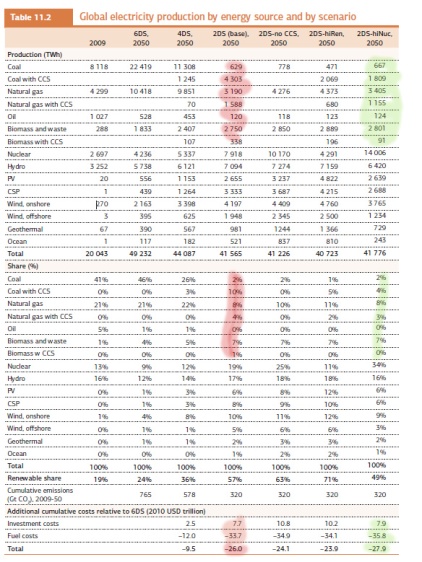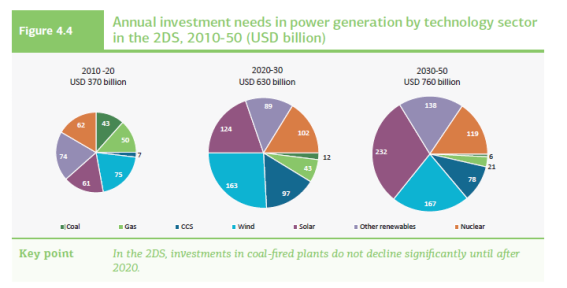I glanced at the IEA report “Energy technology perspectives 2012”. (There is also a 2015 version, but I didn’t have access to that. Annoyingly IEA charges dearly for these reports so that even though they are commonly referred to in discussions, they are not widely available.) In their baseline 2DS scenario IEA estimates cumulative saving (savings in fuel minus investment costs) over 6DS scenario of 26 trillion US dollars by 2050. Interestingly enough they also have a “high” nuclear scenario where they tolerate more nuclear power than in the baseline. In this scenario the savings are largest, 27.9 trillion. Strangely enough this result was buried to the page 384 of the report. Wouldn’t it have been useful to highlight this since there are plenty of people and (believe it or not) politicians who don’t know this? After all this ignorance might make them promote policies that are counter productive in fighting climate change.
We can also look at the required investment level to follow the 2DS scenario. Here IEA assumes large cost reductions for renewable energy sources. This might or might not happen, but let us just accept this for now. I highlight some relevant numbers from the report in the following table.
| Source | Investment 2030-2050 per year (billion) | Production 2050 (TWh) | TWh/billion |
| Nuclear | 119 | 7918 | 66.5 |
| Wind | 167 | 6145 | 36.8 |
| Solar | 232 | 5988 | 25.8 |
| Wind+solar | 399 | 12133 | 30.4 |
As you can see, even though IEA has baked in massive cost reductions assumptions into solar and wind by 2050, they still deliver less than half as much electricity per investment than nuclear (for which IEA didn’t seem to assume learning effects). IEA 2DS baseline is not a cost minimizing scenario, but presumably reflects sufficiently conventional wisdom that authors believe is more palatable for IEA funders.
What would happen if we were to simply divert investments spent from more costly decarbonization options to nuclear? That 399 billion for wind and solar would then enable about 14000 TWh/year more carbon free electricity than the 2DS baseline. This would be enough to eliminate coal, coal+CCS, natural gas, natural gas+CCS, biomass+waste, and biomass+CCS from the electricity mix at 2050 with more than 1000 TWh left over. As these sources of electricity disappear, more than 100 billion a year is also saved in investment costs and lots more in fuel costs. Based on the difference between IEA 4DS and 2DS scenarios, I estimate around 20 trillion additional cumulative savings in fuel costs. Not bad, I would say given the speculative nature of CCS technology, environmental and social impacts of bioenergy schemes, and the need to decarbonize also other sectors than electricity production. (Incidentally, it tells something of the absurdity of current energy discussions, that many celebrate large investments as a good thing. It doesn’t seem to matter what the investment actually buys. More expensive the better, because that means more investment and larger business opportunities in “cleantech”.)
Do I think this will happen in the near future? Of course I don’t. If there would be a wartime-like urgency, who knows, but as it stands such scale up is not going to happen. However, even if unrealistic this option is MORE realistic than the renewables-only party line. It is more realistic economically, technically, and in terms of material limitations. Since it is not going to happen, (as I have said many times before) we can look forward to much more than 2 degrees warming.






3 comments
Comments feed for this article
10/06/2015 at 2:49 AM
puuheppa
Emission reductions are not enough, but we need to get all the way to 100 % of non-polluting energy. There is no other choices available.
That is because if we see rapid, China like economic growth and Africa like population growth in Africa and South-West Asia and South America, then the emissions are increasing faster than we can ever cut those emissions. IEA of course assumes that Africans will remain poor and there is only moderate economic growth in the rest of developing world. But I found this assumption at least ethically questionable.
There is however good discussion today, that renewables are pushing down the price of electricity. In 2014 the price of industrial electricity in Germany was the lowest on Europe. And also today prices are in their record lows.
This means that the profitability of coal companies are taking very hard hits. Natural gas baseload generators are already shutting down their operations for good, because it is no longer profitable. Also Lignite power is suffering. Therefore we might expect that all baseload power in Germany has fallen into bankruptcy by around 2020 to 2025. And new nuclear power or service life extension of old plants has not been profitable investment for a decade.
Of course this hole must be filled with even more wind and solar. And the spiral of Deat for utility companies is ready.
Not sure how intentional this was, but perhaps this was the Great German Plan to go 100 % renewables. Make the market conditions for non-renewable power generation so hard that that that whole sector falls into bankruptcy in rapid pace. At least German Greens foresaw already in 2012 that Germany will go to 100 % renewable electricity by 2030. It was not that Germany should go there but Germany will go to 100 % renewable electricity via bakruptcies of German utility companies.
Now it seem increasingly likely that this bold prediction might actually be accurate. And there are 100 % renewable skenarios produced in every countries. Even in Finland that is one of the most hostile countries against renewable energy.
21/04/2016 at 7:12 PM
IRENA plans: cost optimal…not! | PassiiviIdentiteetti
[…] have written before how IEA sometimes hides politically inconvenient results in their reports. Now IRENA has published a new […]
08/03/2017 at 9:39 AM
Steve Bernard
There are 100% renewable countries today. They are known as the poorest countries in Asia and Africa. Intermittent sources such as wind and solar and even hydro are insufficient to support a modern industrial society. Add in storage and backup fossil fuel generation and the cost of energy becomes so high as to drive energy-intensive industries abroad. I guess the Germans can look forward to a return to their medieval way of life of farming and fishing, along with a heavy dose of tourism to their picture-postcard little villages.